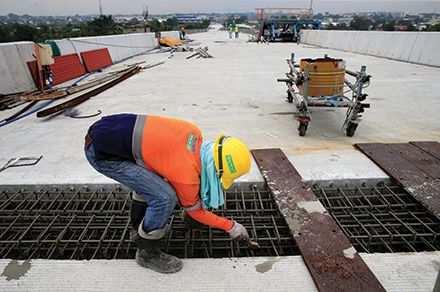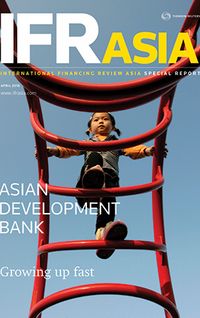President Duterte’s ambitious infrastructure programme may be laying the foundations for stronger long-term growth, but the government’s funding strategy is not keeping everyone happy.
The Philippines’ infrastructure problems are immediately apparent to anyone arriving in Manila’s main airport. The traffic slows metres from the ageing Ninoy Aquino International Airport terminal, and gets steadily worse throughout the ride to the gleaming new business district of Bonifacio Global City. The five-kilometre journey takes 45 minutes.
President Rodrigo Duterte has run out of patience. A year after he took office, his administration had ramped up infrastructure spending to 5.4% of GDP, from 4.5% in 2016. It is set to hit 7.3% of GDP in 2022.
The five-year “Build, Build, Build” programme has identified 75 flagship infrastructure projects totalling US$160bn–$180bn, including the expansion of Clark airport and Manila’s first mass transit subway. Already 23 of those are fully approved.
The increased spending has lifted confidence in the economy, but Duterte’s infrastructure agenda also brings with it concerns and contradictions that have not gone down well with everyone.
As well as spending more, the government has shelved many of the public-private partnerships that were in the works under the previous administration. Most of the projects on the new priority list are to be financed by the government, or through overseas development assistance (ODA) loans from richer nations, mostly Japan and China, leading to criticism that the government is piling on debt.
Economists are mostly comfortably with the additional borrowing, noting that the Philippines’ solid growth and strong balance sheet (partly the result of under-investment by previous administrations) gives it some room to manoeuvre.
But proponents of the PPP model are less impressed. Only two of the 75 projects on Duterte’s list involve private sector partners, and sponsors face an uncertain future for the projects that did not make it on the Build, Build, Build list. Unsolicited bids are allowed, but there are concerns of a lack of coordination.
“The government says it is open (to unsolicited bids) but the entry points are not so well defined,” said Sol Castro, managing director at CFP Transaction Advisors, an independent consultancy. “Private sector partners need to create their own market.”
Duterte’s list dropped the upgrade of NAIA, Manila’s main airport, in favour of the rehabilitation of the Clark airbase. But two bidders, Filipino-Indian venture Megawide GMR and a “super consortium” of seven of the country’s biggest firms, have since submitted unsolicited proposals to expand NAIA.
The economic development agency has also accepted an unsolicited bid from San Miguel to build a mega, six-runway airport in Bulacan, north of Manila but south of Clark. A group backed by Henry Sy’s Belle Corporation has also proposed an airport at Sangley Point in Cavite, less than 20km south of NAIA.
Unsolicited proposals, if accepted, are open to rival bidders via a Swiss challenge, but there is no government funding for feasibility studies, and officials are focusing their efforts on projects that can be completed under the current administration.
That has led critics to claim that Duterte, having complained of delays under the PPP format, has himself caused unnecessary delays to projects that did not make the Build, Build, Build cut.
NO MORE PPP?
Funding for Duterte’s projects comes almost entirely from the national government and ODA loans.
The first phase of the Metro Manila Subway project, for instance, is funded by a ¥575.7bn (US$5.3bn) loan from the Japan International Cooperation Agency and US$2bn from the Philippines.
Despite Duterte’s well-publicised dislike of the PPP model, the government says it has not abandoned the concept. Finance Secretary Carlos Dominguez said in April that the government was following a “hybrid” PPP model, where projects use a combination of state funds, ODA loans and investment-grade bonds to speed up execution.
Bankers remain hopeful that the financing markets will play a role.
The ADB, and others, have pushed the bond market as a tool for project financings, but take-up has been slow. Aboitiz Power refinanced its Tiwi-Makban geothermal complex through a bond in 2016, using credit enhancement from the ADB and the Credit Guarantee and Investment Facility (CGIF). But the notes were not widely sold, and critics say the credit enhancement was a response to single-borrower limits, rather than a vindication of the project financing structure.
“We can do project bonds in the Philippines. All the workings are already in place,” said Eduardo Francisco, president of BDO Capital.
While some completed projects have made their way into the bond markets, efforts to use the capital markets for greenfield projects have yet to bear fruit. The CGIF is promoting a construction risk guarantee to help sponsors access institutional capital before their projects are operational, but Francisco argues that the liquid local banking system is still the first port of call.
“The real reason it hasn’t moved is that companies find these guarantees expensive,” said Francisco. “Borrowers will first do project financing with the banks, and then later when it is operational they can do a project bond.”
The local capital markets have shown demand for infrastructure assets. NLEX, the operator of the North Luzon Expressway, sold Ps6bn (US$115m) of seven-year and 10-year bonds in March to refinance debt. NLEX is majority owned by Metro Pacific Investments, but bondholders do not have recourse to the sponsor.
At least one company is looking at an infrastructure IPO on the Philippine Stock Exchange, which relaxed its listing requirements for PPP issuers in early 2017. The PSE rules waive the track record requirement for major infrastructure projects with a value of at least Ps5bn and minimum contract of 15 years, giving sponsors another option to recycle their capital once the construction phase is complete.
The challenge of actually getting to the PSE, which moved into its new home in Bonifacio earlier this year, may even present another project finance opportunity.
Among the many unsolicited proposals is a plan from Andrew Tan’s Alliance Global Group to build a monorail connecting BGC to the existing transit network. And once the subway is completed in 2025, the slow road from the airport may finally be a thing of the past.
To see the digital version of this roundtable, please click here
To purchase printed copies or a PDF of this report, please email gloria.balbastro@tr.com



